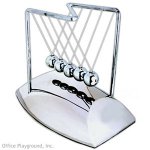http://en.wikipedia.org/wiki/Electric_current
http://en.wikipedia.org/wiki/Electric_current
Metals
A solid conductive metal contains mobile, or free electrons, originating in the conduction electrons. These electrons are bound to the metal lattice but no longer to an individual atom. Even with no external electric field applied, these electrons move about randomly due to thermal energy but, on average, there is zero net current within the metal. Given a surface through which a metal wire passes, electrons move in both directions across the surface at an equal rate. As George Gamow put in his science-popularizing book, One, Two, Three...Infinity (1947), "The metallic substances differ from all other materials by the fact that the outer shells of their atoms are bound rather loosely, and often let one of their electrons go free. Thus the interior of a metal is filled up with a large number of unattached electrons that travel aimlessly around like a crowd of displaced persons. When a metal wire is subjected to electric force applied on its opposite ends, these free electrons rush in the direction of the force, thus forming what we call an electric current."
When a metal wire is connected across the two terminals of a DC voltage source such as a battery, the source places an electric field across the conductor. The moment contact is made, the free electrons of the conductor are forced to drift toward the positive terminal under the influence of this field. The free electrons are therefore the charge carrier in a typical solid conductor.

